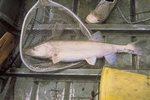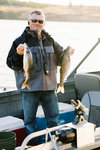

The story of the northern pikeminnow and the Columbia River is a study in unintended consequences.
The population of pikeminnow ballooned in sections of the Columbia and Snake rivers once an extensive labyrinth of dams began slowing the flow of those rivers in the name of irrigation and hydroelectricity. Since they are a native species, the swollen populations of the fish wouldn’t have been much of a concern except for the fact that they are particularly fond of juvenile salmon and steelhead smolts.
Northern pikeminnow are so salmon-hungry that the Bonneville Power Administration has put a bounty on their heads in order to reduce their impact on struggling salmon runs. A press release from the BPA described northern pikeminnows as “voracious eaters, consuming millions of young salmon and steelhead every year.”
Considering the aim of the program to reduce the population, it seemed somewhat counterintuitive to learn in a recent BPA press release that fishery managers release more than 1,000 tagged northern pikeminnow each year with the promise of $500 to any angler who returns one. And yet, that’s exactly what the Pacific States Marine Fisheries Commission does each year in advance of the Northern Pikeminnow Sport Reward Program fishing season, which runs from May 1 through Sept. 30.
Steve Williams, senior program manager and pikeminnow overseer for PSMFC, says that releasing the tagged pikeminnow is an essential component to the program because it allows managers to calculate the overall success rate of anglers. He explained that biologists use electrical pulses to incapacitate and capture pikeminnow in the spring. Those fish are then outfitted with tags and released back into the Columbia River system.
“It is an incentive, but we want those tags back because that’s how we calculate our exploitation rate for the year statistically,” said Williams, who noted that the goal of the pikeminnow program is to reduce the overall population of fish over 9 inches by 10 to 20 percent. He said that studies have shown that a reduction within those parameters can result in an overall reduction of predation on juvenile salmonids by up to 40 percent.
Last year, the Northern Pikeminnow Sport Reward Program paid out nearly $1,542,000 between approximately 1,100 participating anglers. The program only pays for fish at least 9 inches in length, and 191,483 pikeminnow matching that description were returned. The top 20 anglers this year averaged nearly $30,000, with the leading angler earning nearly $84,000 thanks for a haul of about 10,000 fish.
The more pikeminnow an angler returns, the more each is worth, with a minimum of $5 per fish and a maximum payout of $8, unless it’s one of those tagged $500 bonus fish. Williams says that each year fish managers release 1,130 of those tagged northern pikeminnow.
Michelle Helms, media relations with the BPA, noted that about 4.8 million pikeminnow have been removed from the Columbia River systems since the Sport Reward Program began more than a quarter century ago.
“The program, as it is now, began in 1990. Before that there were some activities to manage that population but I don’t have any details about what they were or how they were administered,” said Helms. She noted that the BPA funds the program in order to fulfill mitigation requirements related to the impact on salmon runs caused by the dams they operate on the Columbia River system.
As it turns out, pikeminnow thrive in the slowed river flow environment created by the succession of dams.
“What the dams did is it created more of those backwaters and it advantaged the pikeminnow tremendously,” explained Williams. “The construction of the dams created just the perfect conditions for them to flourish … They tend to be that ambush predator that’s looking for that edge.”
Neither Williams or Helms could provide any sort of perspective for the historical abundance and range of northern pikeminnow in the Pacific Northwest, but both noted that their native origin complicates matters.
“Because the pikeminnow is native we do want to manage them but we don’t want to eliminate them,” said Helms.
Williams argued that because there is no impetus to remove all of the northern pikeminnow in the Columbia and Snake rivers, there is nothing to be risked by releasing tagged fish back into the river system.
“It’s not like a hatchery operation where you’re adding to it. You’re dealing with existing critters,” said Williams. “In the five years that I’ve been doing this program here I have not had anybody come back and say, ‘Why have you let those fish go?’ Because the objective is to be able to judge your exploitation rate.”
Williams noted that some of the best pikeminnow angling results are actually recorded below the Bonneville Dam in the fall, but the peak pikeminnow prospects occur in the spring below The Dalles boat ramp.
“That’s generally every year one of our biggest catch areas,” said Williams, who estimated that about 40,000 pikeminnow are reported caught in The Dalles area each spring. He added that the mouth of the Yakima and the area right below McNary Dam are often hot spots for pikeminnow anglers, and he’s seen the fish bite on everything from raw salmon eggs, to chicken livers, nightcrawlers and spinners.
“It just depends on the situation,” said Williams. “One of the interesting ones I always get a kick out of is some guys have been using white, extra sharp Tillamook cheddar cheese. It’s gotta be white, that’s what those guys say.”
Williams noted that fish are edible, but most anglers prefer the payout over a plateful of prickly pikeminnow. The pikeminnow returned to fish managers are then trucked to a rendering plant.
“They don’t taste bad. The problem with pikeminnow is they are really bony,” said Williams, who compared pikeminnow to shad.
Williams added that pikeminnow can be targeted all year long but they can only be returned for a payout from May 1 through Sept. 30 during the Sport Reward season. Anglers must have a fishing license to fish for pikeminnow.